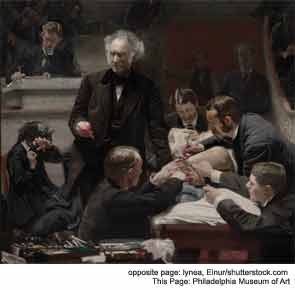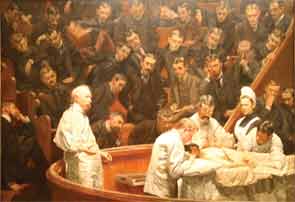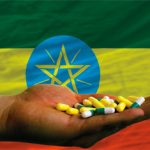Over the next few decades, a better understanding of sepsis began to dramatically transform physicians from being purveyors of home remedies and quackery to more thoughtful practitioners. Clinicians began to better understand how to prevent bacterial contamination. This progression was highlighted in Eakins’ largest work, the operating theater masterpiece, entitled “The Agnew Clinic” (see Figure 2). This painting was commissioned for $750 in 1889 by three undergraduate classes at the University of Pennsylvania to honor their teacher, Dr. D. Hayes Agnew. In it, he is seen wearing a white smock performing a mastectomy. His assistants are also wearing white, suggesting that a new sense of cleanliness pervaded the environment. The patient is swathed in white sheets and the nurse is wearing a white cap. Finally, medicine was beginning to emerge out of the depths of darkness.


The White Coat: A Symbol of Credibility
Over the past hundred years, the white coat has served as the physicians’ symbol of recognition, professionalism, and trust. It identifies the wearer as being competent and trustworthy. This is especially important at the time of a new patient encounter, when several undercurrents are at play.4 The patient and doctor not only exchange medical information, but also assess each other to determine whether a strong therapeutic relationship can be built. What is the doctor’s appearance? What is his or her demeanor? Wearing a white coat helps.
Numerous studies have confirmed that patients have the most confidence in doctors who wear one. For example, patients surveyed in a recent study at one outpatient clinic overwhelmingly preferred doctors photographed in formal attire with a white coat.5 The patients also said they were more likely to divulge their social, sexual, and psychological worries to the clinicians in the white coats than to the other doctors. Similarly, a survey of patient and family-member preferences in an intensive care unit setting observed that a white coat was preferred over doctors wearing surgical scrubs or business suits by a 2:1 ratio and a fourfold margin, respectively.6
The white coat has morphed into a symbol of medical integrity. The Arnold P. Gold Foundation of New York City, whose mission is to perpetuate the tradition of the caring doctor by emphasizing the importance of the relationship between the practitioner and the patient, has actively promoted the White Coat Ceremony to welcome entering medical students and help them establish a psychological contract for the practice of medicine. The event emphasizes the importance of compassionate care for the patient as well as scientific proficiency. White-coat ceremonies have gained popularity worldwide, adding to the prestige of this garment.

